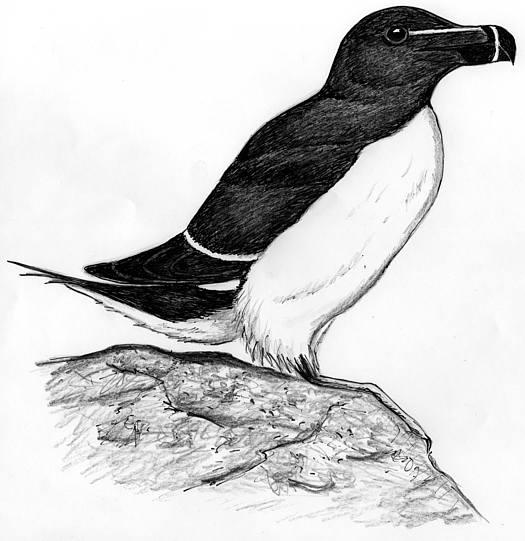
Dear Bird Folks,
I was walking along a beach in North Truro (MA) a few weeks ago when I came upon this dead bird (see photo). I had no idea what it was, but a passing lady told me it was a “Razorbill.” I had to believe her since I don’t know what a Razorbill looks like. Please take a look at my photo and tell me what you think. Is that lady right?
– Ron, Cranston, RI
Wow, Ron,
Over the years people have sent me some amazing photos. Some pictures are simply beautiful images of birds, while others have a warm artsy feel to them. However, none of those things apply to the photo you sent. What the heck is that? I know it’s not your fault, but that’s one scary looking image. It appears to be combination of bird parts and old socks from the bottom of my laundry bag. In an effort to identify the bird for you I printed out your picture, turned it upside-down, held it up to a mirror, squinted with my good eye and only then could I maybe see that it was a Razorbill…or perhaps my old socks. I’m still not sure.
I think in this case, Ron, it will be easier to believe the passing lady. I could spend the next five paragraphs discussing why that dead bird may or may not be a Razorbill, but that would be too boring to read. (I’m getting bored just thinking about it.) So instead, I’ll just say: Wow! Hey, Ron, you found a dead Razorbill. Lucky you. Razorbills are birds that spend most of their lives out at sea, so seeing one close up is a treat. It’s too bad this one bird happens to be dead, but it’s an interesting find nonetheless. Just don’t stand downwind of it.
For those of you who don’t know, Razorbills are crow-sized black and white seabirds that look a lot like penguins. Some folks even refer to them as the “penguins of the north,” even though they aren’t closely related, not even by marriage. Razorbills belong to a group of birds known as “auks,” which are birds of the open ocean. They don’t often come to land except to make more auks. All auks are strong and agile swimmers, and while Razorbills are decent flyers, many auks are not. Their stubby wings are better designed for underwater swimming than for flying in the air. Occasionally, auks get caught in the strong winds of winter storms. When that happens the birds are unable to control where they go and may not be able to stop themselves. They are like flying Toyotas. If the winds blow the birds away from water and onto land they are in major trouble, because auks cannot take off from land. Unless some Samaritan comes along to take them to the nearest ocean the stranded birds will not survive for very long and will eventually end up looking like my old socks.
Here’s a question: If the birds can’t take off from land, how are they able to breed? Don’t they lay their eggs on the ground? Yup, they sure do lay their eggs on the ground, but the ground they nest on is usually some rocky cliff, high above the ocean. All the birds have to do to become airborne is jump off the cliff and start flapping. As you can imagine proper cliff side real estate is hard to find. Once a pair of Razorbills finds a good spot to nest they don’t give it up. They will return to the same site year after year, vigorously defending it against all comers. One female, which was banded back in 1962, was still returning to the breeding grounds thirty-eight years later and she was still cranking out the kids. And as you may have guessed, none of the kids ever call.
Over the past few weeks I have written about birds in Florida, the Carolinas and the Desert Southwest. (It’s probably my way of trying to survive this New England winter.) However, Razorbills have little use for any of those warm locations. They are birds of the North Atlantic and are proud of it. They breed along the frigid waters of Iceland, Russia, Canada and in the coldest waters of them all, coastal Maine. After the breeding season, Razorbills slowly drift south but they usually only travel far enough south to get away from the ice flows. Many of these birds can be found gathering on nearby Georges Bank. Occasionally, either food or bad weather will cause flocks of Razorbills to move closer to the shore. This is when we have our best chance to see them. In fact, right about the time you found the dead Razorbill in North Truro, over a thousand of them were seen off Race Point Beach in Provincetown, and these birds were all alive, which is way better than being dead.
It’s hard to know what caused the death of the bird you found, Ron. Like all seabirds Razorbills are extremely susceptible to oil spills and many of them die each year after being caught in those horrific drift nets. Razorbills face a long list of scary life and death challenges everyday, but things could always be scarier. They could drive a Toyota.